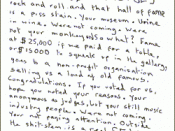ÃÂIt is true that manipulation theory sometimes finds a special place in its scheme for those rare cultural objects which can be said to have overt political and social content: thus, 60s protest songs, The Salt of the Earth, Clancey SegalÃÂs novels or Sol YurickÃÂs, chicano murals, and the San Francisco Mime Troop. This is not the place to raise the complicated problem of political art today, except to say that our business as culture critics requires us to raise it, and to rethink what are still essentially 30s categories in some new and more satisfactory contemporary way.ÃÂ (Jameson 139)I initially read this quote as a praise of political art as so worthy an object of study that its complexities could not be fully addressed within the scope of JamesonÃÂs work. In other words, Jameson was humbly admitting that political art is deserving of its own lengthy analysis. Why, though, is Jameson incapable of addressing political art (and implicitly counter culture) for more than a page in his nineteen page essay describing modern culture?As I reread the quote, I began to hear a dismissive tone in the words ÃÂspecial placeÃÂ and ÃÂrare.ÃÂ
How rare is overt political and social content? How rare are ÃÂ60ÃÂsÃÂ protest songs? While the historicity of the category ÃÂ60ÃÂsÃÂ can be appreciated, and indeed JamesonÃÂs use of it appears to be grounded in skepticism towards the authenticity of political art emerging outside of ÃÂcollective life,ÃÂ it seems as if Jameson is using it to contain a threat to his argument. The threat, that is, that overt political art and action have been present and overt since before the 1960ÃÂs, and continue to persist now. I feel that, to a significant extent, his position as academic shields him from and allows him to theorize away a counterculture...


